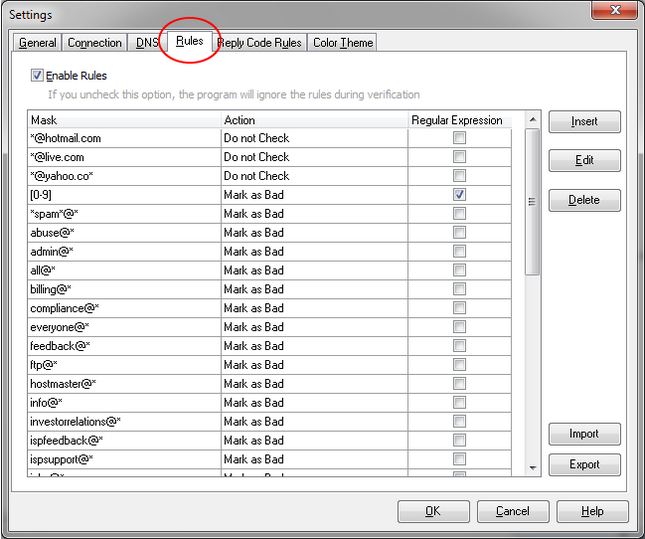Email Validation Rules Explained
Although the Advanced Email Verifier has a very good email validation success rate, it is simply not possible to guarantee a 100% accuracy level due to certain factors that are beyond our control. The level of accuracy you can obtain depend on the inbound SMTP connection policy of the remote ISP or ESP, reputation of the incoming connecting IPs and many other factors.
To save your time and protect your IP address from being blocked, we added rules for certain email addresses and domains that force the program to automatically mark the email addresses as "Bad" or "Unknown" without even trying to validate them.
In this article we give the detailed explanation of why certain email addresses/domains are excluded by the rules and what to do if you still want to validate them.
Navigate to the Advanced Email Verifier Settings and click on the Rules tab to check the built-in rules.
Why Not Check Emails from the Yahoo.co*, Live.com, Hotmail.com, and Outlook.com Domains?
We excluded the email addresses from the @yahoo.co*, @live.com, @hotmail.com, and @outlook.com domains from verification because checking email addresses from these domains from the IP address WITHOUT proper Forward-Confirmed Reverse DNS and PTR records will cause the IP address block. By default the email addresses from these domains are marked as”Unknown” with the “Result set by Rule” response.
You can delete the rules for these domains and verify @yahoo.co*, @live.com, @hotmail.com, and @outlook.com email addresses if you:
- install the Advanced Email Verifier on a Windows VPS or server with proper PTR and Forward-Confirmed Reverse DNS records;
- upload the webs script to the domain with proper PTR and Forward-Confirmed Reverse DNS records and verify emails through the script; or
- verify email addresses through BPSocks email validation API.
Why Delete "Role Addresses" from Your List?
We have the rules to mark "role addresses" such as abuse@*, admin@*, info@*, feedback@* and many others as "Bad". Unlike a personal email account such as "julia@XYZ.com" a role account has a specific function within an organization and is intended only to receive messages related to that function. For example, "abuse@XYZ.com" is the email address a company uses to receive email abuse reports. Many email service providers will suppress role addresses from their customers' mailing lists to prevent email sending to those addresses."Role accounts" are tied to specific functions within a company, they are not intended for receiving email marketing messages.
Role account addresses are usually posted on public web pages which makes them vulnerable to email harvesters. These email addresses often end up in master databases, which are rented or sold to email marketers looking to build up their lists faster than they could if they used the opt-in method. Email lists with lots of role accounts can also make you look like a spammer to blocklist agencies such as SpamHaus. In addition, some blacklists deliberately use role addresses as "honeypots" to trap spammers. They claim that any email sent to those addresses is spam by default because the email address was obtained and used without permission.
With that said, whether someone files a spam complaint on an email sent to a role account, or your list contains too many in proportion to personal email accounts, you can end up looking like a spammer to an ISP or blacklist, and your email marketing messages won't get delivered.
For all above reasons, we set the Advanced Email Verifier to automatically mark role accounts as "Bad" in order you can filter them out of your list. If you still want to verify role email addresses, delete the rules for them.
Why Exclude Some Other Domains?
In addition to above, we have the rules to mark the email addresses from certain email domains such as cox.net, aol.com, comcast.net, bellsouth.net, verizon.net, att.net, charter.net, netzero.net, aim.com, and sbcglobal.net as "Unknown" without verification. This comes from the inability to verify the emails from these domains by simulating a message sending to the recipient email server because the recipient email server requires that a REAL message is sent. Thus, it is impossible to verify whether the address is good or not. You won't know definitively until the message bounces because these mail servers won't cooperate and cannot be checked without sending a real message to them. Plus, these domains may sometimes blacklist the connecting IP address. If you still want to verify email addresses from the mentioned domains, delete the appropriate rules.
In addition to default rules, you can add your own rules to the list to save your time for email verification.

Get G-Lock Email Verifier for Free Today!
If you are getting too many bounce and undeliverable emails and being blocked as a result, G-Lock Email Verifier can help you clean your list from bad email addresses and invalid domains and increase your e-mail campaign performance by focusing only on REAL prospects… No Monthly Fees!
This software is a must have in your emailing arsenal. It is simple to use but very powerful and the support is always available through live chat and very reponsive. Remote assitance is also provided when needed.


